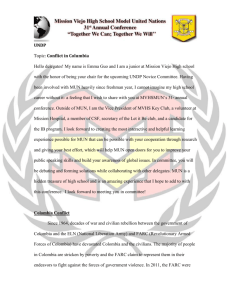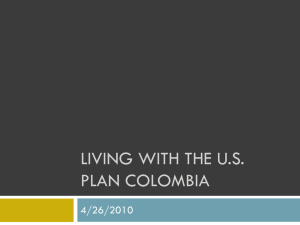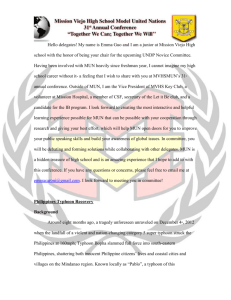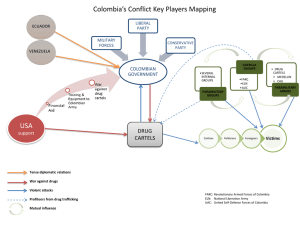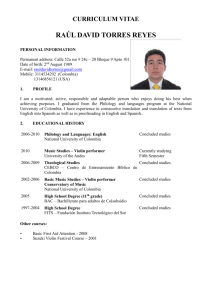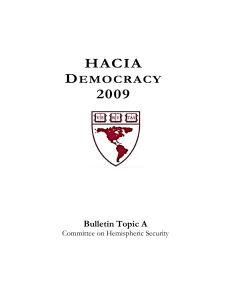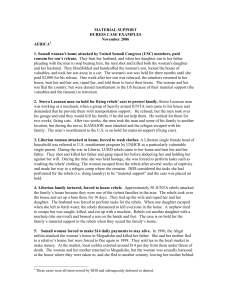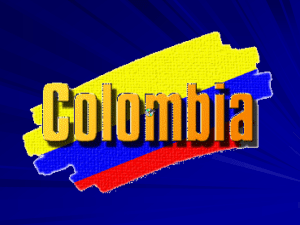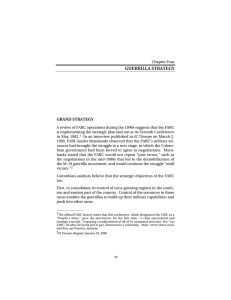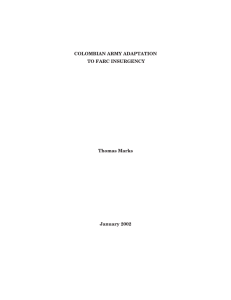Imagining, and achieving a New Colombia There are different grand
advertisement
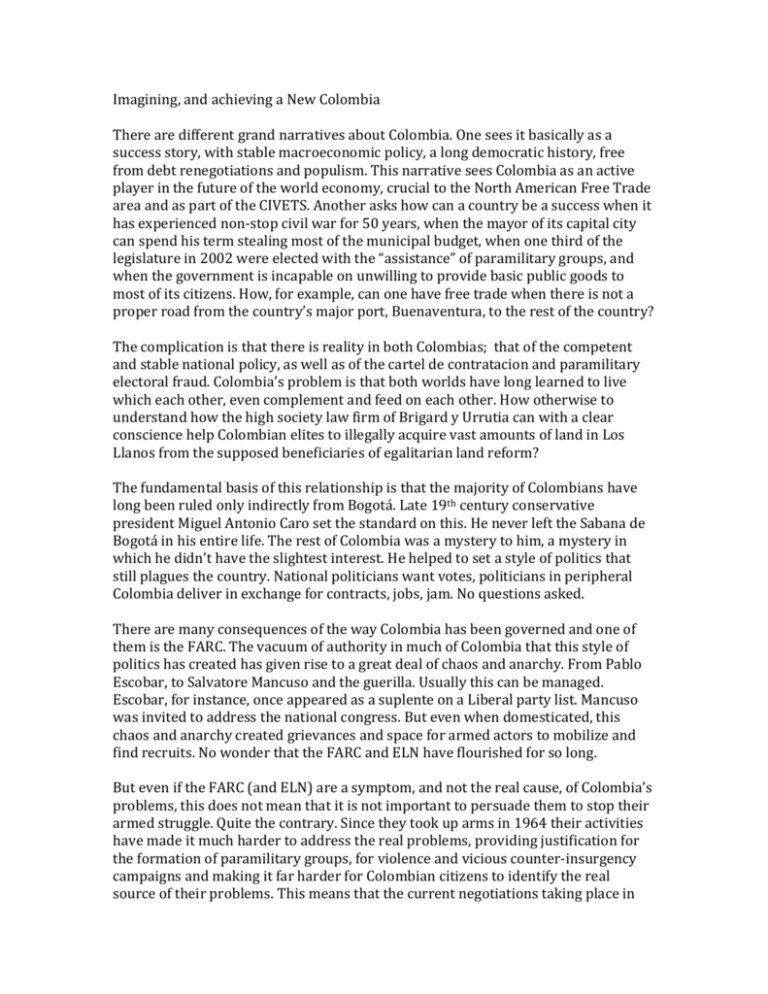
Imagining, and achieving a New Colombia There are different grand narratives about Colombia. One sees it basically as a success story, with stable macroeconomic policy, a long democratic history, free from debt renegotiations and populism. This narrative sees Colombia as an active player in the future of the world economy, crucial to the North American Free Trade area and as part of the CIVETS. Another asks how can a country be a success when it has experienced non-stop civil war for 50 years, when the mayor of its capital city can spend his term stealing most of the municipal budget, when one third of the legislature in 2002 were elected with the “assistance” of paramilitary groups, and when the government is incapable on unwilling to provide basic public goods to most of its citizens. How, for example, can one have free trade when there is not a proper road from the country’s major port, Buenaventura, to the rest of the country? The complication is that there is reality in both Colombias; that of the competent and stable national policy, as well as of the cartel de contratacion and paramilitary electoral fraud. Colombia’s problem is that both worlds have long learned to live which each other, even complement and feed on each other. How otherwise to understand how the high society law firm of Brigard y Urrutia can with a clear conscience help Colombian elites to illegally acquire vast amounts of land in Los Llanos from the supposed beneficiaries of egalitarian land reform? The fundamental basis of this relationship is that the majority of Colombians have long been ruled only indirectly from Bogotá. Late 19th century conservative president Miguel Antonio Caro set the standard on this. He never left the Sabana de Bogotá in his entire life. The rest of Colombia was a mystery to him, a mystery in which he didn’t have the slightest interest. He helped to set a style of politics that still plagues the country. National politicians want votes, politicians in peripheral Colombia deliver in exchange for contracts, jobs, jam. No questions asked. There are many consequences of the way Colombia has been governed and one of them is the FARC. The vacuum of authority in much of Colombia that this style of politics has created has given rise to a great deal of chaos and anarchy. From Pablo Escobar, to Salvatore Mancuso and the guerilla. Usually this can be managed. Escobar, for instance, once appeared as a suplente on a Liberal party list. Mancuso was invited to address the national congress. But even when domesticated, this chaos and anarchy created grievances and space for armed actors to mobilize and find recruits. No wonder that the FARC and ELN have flourished for so long. But even if the FARC (and ELN) are a symptom, and not the real cause, of Colombia’s problems, this does not mean that it is not important to persuade them to stop their armed struggle. Quite the contrary. Since they took up arms in 1964 their activities have made it much harder to address the real problems, providing justification for the formation of paramilitary groups, for violence and vicious counter-insurgency campaigns and making it far harder for Colombian citizens to identify the real source of their problems. This means that the current negotiations taking place in Cuba create a great window of opportunity for Colombia to put aside one of the impediments they face to building a new society. So a presidential election that revolves around the issue of whether or not to negotiate with the FARC is a historic moment for Colombians, not least because for the first time ever there is the genuine prospect of an agreement being made. But if the FARC are not the real problem couldn’t there be an alterative to this negotiation? The history of the Uribe government shows that the answer is no. In 8 years of intensified military activity against the FARC there were undoubted successes. The FARC withdrew from many areas in which they had previously been dominant, though this had as much to do with paramilitary groups as with the army. Several top leaders were killed. The reason that negotiations are taking place now is due to a large extent to the military success of the Uribe government and a reassessment by the FARC of what they can hope to achieve through armed struggle. But it is important to draw the right lessons from this experience. After eight years of conflict the FARC were far from defeated. Others have replaced the leaders who were killed and the FARC remains organized and powerful. The reason for this is obvious. While on the one hand the Uribe government focused on the military conflict, on the other hand it intensified “politics as usual” in Colombia. For example, by making any deal that was necessary to try to re-write the constitution to engineer presidential re-election. Ultimately, the Uribe campaign against the FARC was not and could never have been successful because its political foundations rested on precisely the factors that created the FARC in the first place – the indirect rule of the periphery by the center. What one hand gave, the other hand took away. Nothing better illustrates this than the weekly consejos comunales. While on the one hand these represented a genuine attempt to extend the presence of the state outside the Sabana de Bogotá, on the other they provided an unrivaled platform for the distribution of patronage. More than simply negotiating with the FARC this experience suggests the crucial fact that this negotiation has to be used as a window of opportunity for grappling with the real problems which created the FARC and so many of Colombia’s problems in the first place. Signing a peace with the FARC and “declaring victory” will have about as much impact as many other similar demobilizations in Colombian history; from that of Guadeloupe Salcedo in the 1950s, through that of the M-19 and the EPL (whose combatants were then recruited by Fidel Castaño into the autodefensas). Signing a peace deal with the FARC will be a good thing for many reasons, because it brings their combatants into normal life, because it frees many rural people from fear and tyranny and because it undermines the rational for many forms of counterFARC extremism. But it will only lead to a different Colombia, to a change in the circumstances which led to the creation and flourishing of the FARC, Escobar and Mancuso if it can play a role in changing the politics of Colombia, in disrupting the indirect way in which the center rules and relates to the periphery. Remarkably, the negotiators in Havana have understood this fundamental truth. The first plinth for the peace agreement, which has already been signed, calls for rural development. The second asserts the need for a shift in the political center of society to the neglected periphery. Together they constitute what High Commissioner of the Peace Sergio Jaramillo calls a “territorial peace”. Achieving such a peace will be difficult. It entails a fundamental change in the power relationships not simply between the core and the periphery, but between the citizens of the core and the rest of Colombia. For this to be possible it is not sufficient to sign a deal in La Habana. Indirect rule has to stop. Colombia needs political leaders who can break with the traditional way of doing politics. This is not an easy thing to do since the current style of politics is deeply ingrained into the psyche and strategies of politicians. To change things is risky and it requires great feats of resolve and imagination. But it can be done. At a practical level this change will be greatly complemented by working to build inclusive democratic institutions in the periphery. In the end it is rural people who have the greatest vested interest in peace and security, high quality schools, health care, roads and all the public goods they lack. Recent experience in Brazil and India provides many successful models of how civil society can be helped to organize to demand these things, as does Colombian history. For example, the creation of ANUC in 1967 by President Carlos Lleras to push forward his agenda of agrarian reform, greatly disrupted traditional politics. It was not the failure of ANUC that was the problem, but its success. When Conservative President Misreal Pastrana came to power in 1970, he was horrified at the empowerment of rural Colombian society that ANUC represented and threw the weight of the state behind crushing the movement. What parts of the job he did not finish, subsequent paramilitary violence did. Subsequent attempts to empower rural society to promote peace and development, such as the Plan Nacional de Rehabilitacion (PNR) or the Plan Nacional de Consolidacion (PNC), failed because they were either captured by traditional politicians or did not have the political capital to get implemented since they represented a potential threat to indirect rule. This experience suggests that after they break with indirect rule, Colombian political elites need to pay careful attention to the design of institutions to empower rural society. Finally, if they succeed, they will have to keep their nerve. The empowerment of rural Colombia is going to be a scary and new thing for them, but it is what needs to happen if they want to be part of a modern Colombia.
